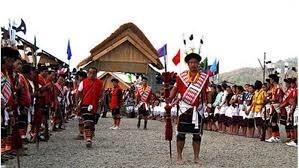Searching for an end to the Naga conflict
- (Paper 2 – Regionalism and Tribal Conflict)
- Despite having huge strategic significance, India’s northeastern frontier has largely remained marginal in the country’s popular imagination as well as mainstream politics. The region has witnessed multiple crises including bloody insurgencies, but still lacks the emotional resonance of the Kashmir conflict due to geographical, cultural, and ethnic factors.
What is Naga conflict?
- Naga conflict is considered by India to be an internal civil war and by the Nagas to be the self-defence of an independent people against an external aggressorin Nagaland.
- Historically the Nagas were head-hunters which may have contributed to their independence throughout the waves of
- It is an extraordinarily complicated conflict whose management has involved a mix of violent response and
Who are the Naga people?
- The Naga people are various ethnic groups native to the northeastern India and northwestern
- The groups have similar cultures and traditions, and form the majority of population in the Nagaland; with significant populations in Manipur, Arunachal Pradesh and Assam.
How old is the Naga political issue?
- The British annexed Assam in 1826, and in 1881, the Naga Hills too became part of British India.
- The first sign of Naga resistance was seen in the formation of the Naga Club in 1918, which told the Simon Commission to leave them alone to determine for themselves as in ancient times.
- In 1946 came the Naga National Council (NNC) under the leadership of Angami Zapu Phizo, declared Nagaland an independent state on August 14, 1947.
- The NNC resolved to establish a sovereign Naga state and conducted a referendum in 1951, in which 99 % supported an independent Nagaland.
When did the armed movement begin?
- In 1952 Phizo formed the underground Naga Federal Government (NFG) and the Naga Federal Army (NFA).
- The Government of India sent in the Army to crush the insurgency and enacted the Armed Forces (Special Powers)
The peace efforts:
- In 1947, Assam Governor Sir Akbar Hyderi signed an agreement with moderates which was almost immediately rejected by
- In 1975, the government got a section of NNC leaders to sign the Shillong Accord, under which this section of NNC and NFG agreed to give up
- A group of about 140 members led by Thuingaleng Muivah, refused to accept the Shillong Accord and formed the National Socialist Council of Nagaland in 1980.
- In 1988, the NSCN split into NSCN (IM) and NSCN (K) after a violent clash. While the NNC began to fade away, and Phizo died in 1991, the NSCN (IM) came to be seen as the mother of all insurgencies in the
- The present central government and the NSCN-IM have been in peace talks with the Centre since the 1997 ceasefire, had signed a
framework agreement 2015 which was claimed a historic achievement at that time. But a final accord has remained elusive since.
What does the NSCN (IM) want?
- A Greater Nagalim comprising all contiguous Naga-inhabited areas, along with Nagaland. That included several districts of Assam, Arunachal and Manipur, as also a large tract of
- The claims have always kept Assam, Manipur and Arunachal Pradesh wary of a peace settlement that might affect their
- The Nagaland Assembly has endorsed the Greater Nagalim demand – Integration of all Naga-inhabited contiguous areas under one administrative
- Recently, the NSCN-IM has demanded the removal of Nagaland Governor as the Centre’s interlocutor in the peace process, asking for affirmation of the 2015 framework agreement as being “alive in its original form”.
Conclusion:
- It is certain that to end the Naga conflict, a solution will have to be evolved from within, not externally imposed. Thus one way to satisfy the aspirations of different ethnic groups while protecting the boundaries of the existing states in India is to explore the option of cultural autonomy.

